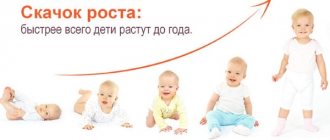Child development by month: what is a child growth chart?
Baby growth charts are a useful tool to help your doctor monitor your baby's overall health and development. Thanks to these tables, you can compare the development of your child with the development of other children of the same age and gender and monitor the dynamics of how the baby grows. For children under 24 months of age, there are the following developmental indicators that doctors usually focus on:
- Head circumference (measured by the most protruding places of the head, shows the dynamics of the child’s brain development)
- Weight in relation to length
- Weight for age
- Length in relation to age
There are different tables for boys and girls, and for children under 24 months and over 2 years.
The information contained in these tables can also be compared with other developmental indicators, compared with family members, and analyzed in relation to other factors. These tables can be downloaded from the following links.
Child development by month: when and how is a child’s height and weight measured?
Most likely, during pregnancy you have already selected a pediatrician or other children's specialist who will monitor the health of your baby, and the first meeting with the doctor will most likely take place at your home a few days after giving birth or being discharged from the hospital. Now at each appointment the doctor will measure and weigh the baby. For the first month of a child’s life, the doctor observes him weekly, then monthly, and when the child is one year old, once every two to three months. If your child needs to be seen more often, the doctor will tell you when to come back and when to make the next appointment. You can and should ask your attending physician about your child’s health. Each appointment with a specialist is another opportunity to make sure that everything is in order and that you are doing an excellent job as a mother.
As a rule, at the appointment the doctor measures:
- Head circumference.
The child's head is measured with a soft measuring tape along the most protruding parts - from the brow ridges above the ears and to the back of the head.
- Length.
Babies rarely lie still, so measuring their body length is not such an easy task, but doctors and nurses do an excellent job of it. To do this, the child is placed on a table or a special stadiometer, the legs are straightened and the body length is measured from the top of the head to the heels.
- Weight.
You will need to unwrap or undress your baby, and the doctor will weigh him on special baby scales.
And here we will tell you what else can be checked during regular examinations:
- Check-up at 1 month
- Check-up at 2 months
- Check-up at 4 months
- Check-up at 6 months
- Check-up at 9 months
- Check-up at 1 year
- Examination at 18 months
- Examination at 2 years
- Schedule of preventive vaccinations
How to use a baby growth chart
Your doctor will tell you in detail how to interpret the measurement results, and here we will give some tips on how to use the table data. The parameters of children differ depending on gender, so you need to compare the results of your baby’s measurements using a separate table for boys or girls.
Head circumference.
At the top of the table is the child's age in months. The numbers are not provided for all months, but each month is indicated by a vertical line. The left side shows head circumference values (in inches and centimeters). Find the correct value for your child and mark the point where the horizontal and vertical lines intersect. Most likely, this point will be on the graph. Follow the graph all the way to the right and the percentage group your child belongs to will be shown on a white background.
For example, let's take a three-month-old girl whose head circumference is 40 cm. The percentage group for this girl is the 50th percentile, that is, half of all three-month-old girls have a larger head circumference, and the other half have a smaller one.
Weight in relation to length.
Find your child's length at the bottom of the grid (in inches and centimeters). On the left side of the grid, note the child's weight (in pounds and kilograms). Mark the intersection point of the horizontal and vertical lines on the graph. Follow the line of the graph all the way to determine which percentage group your child falls into.
For example, let's take a boy weighing 4.5 kg and length 53 cm. This baby belongs to the 90th percentile, that is, 90% of boys of the same length weigh less, and 10% weigh more.
Length in relation to age.
On the left side of the grid, note the child's length (in inches or centimeters), and at the bottom of the table, indicate the child's age in months. Mark the intersection point of the horizontal and vertical lines on the graph. Follow the graph line all the way - the percentage group will be indicated on a white shaded background.
For example, let's take a girl who is 18 months old and 76 cm long. This girl belongs to the 10th percentile, that is, 10% of girls of the same age are shorter in length, and 90% are longer.
Weight in relation to age.
On the right side of the grid, note the child's weight (in pounds or kilograms) and at the top, the age. Mark the intersection point of the horizontal and vertical lines on the graph. Follow the graph line all the way - the percentage group will be indicated on a white shaded background.
Let's take for example a boy who is 12 months old and weighs 10.4 kg. This baby is in the 75th percentile, meaning 75% of one-year-old boys weigh less and 25% weigh more.
Weight and height of the baby after birth - what to pay attention to
In the maternity hospital, doctors record the weight and body length of a newborn baby and carefully monitor changes, especially in low birth weight and premature babies. They are weighed once a day at the same time, mainly in the morning.
- Daily weight gain is considered normal at the rate of 15 g per 1 kg of body weight. Growth is measured only once a week, and its increase will be assessed after 3-4 weeks. By this time it should be at least 2.5-3 cm.
- Most infants, after gaining initial weight, subsequently gain weight quickly, especially during periods of growth spurts. They occur approximately in the middle of the second week of life, and then between 3 and 6 weeks.
- The average child gains an average of 20 grams per day. By the end of the first month of life, the scales at the clinic will show approximately 3.8-4 kg. The height and weight of boys is usually slightly higher than that of girls - the difference in weight can reach 0.4 kg and 1-1.5 cm.
How to interpret the results?
It is best to trust your doctor when interpreting your baby's measurements. It must be remembered that the tables show average data for boys and girls, and the range of normal values is quite wide. There is no single standard for a particular child, but ideally, the baby’s dynamic development should correspond to the schedule - height and weight should increase in proportion to each other.
What are percentiles and what do they mean?
A baby growth chart shows you what percentile, or percentage, your baby falls into compared to other children of the same gender and age. Percentiles are presented in the form of graphs. For example, if your child is in the 70th percentile for length for age, that means that 30% of all children of the same sex and age will be longer and 70% will be shorter.
However, just one indicator does not provide complete information. The pediatrician will compare several different indicators over different periods, track the child's developmental trend and compare it with the graph of average values shown in the table.
Try not to worry about any one metric. The range of normal height and weight values is wide, and many individual factors influence a child's development: genetics, environmental conditions, nutrition, activity level and the presence or absence of health problems. The growth spurt also occurs at different times in different children. For example, growth rates for breastfed and formula-fed children are slightly different. As a rule, children who are breastfed gain weight more slowly than formula-fed children, whose growth spurt and period of intense weight gain occur after three months. As for weight, as a rule, it doubles by five to six months, and triples by one year. But it is best to discuss all questions about the baby’s growth rate with a pediatrician.
As the baby grows, the size of the diapers also changes. To make sure the diaper fits your baby without any leaks, check the diaper size by weight chart.
How does a newborn gain weight (by week)
Active weight gain in infants occurs in the first eight weeks of life. This is a normal reaction of a child’s body to a change in living conditions, and adaptation to a new diet and regimen.
| Age | What happens to the baby's weight |
| First 3 days of life | Physiological weight loss (up to 7-10% of initial body weight) |
| First week of life | A newborn baby fed with breast milk will gain about 100 g in weight in 1 week. |
| Second week of life | The toddler continues to grow and gradually gain body weight. A healthy baby will add up to 250 g to the initial weight in 2 weeks. |
| Third week of life | During the 3rd week after birth, the baby’s weight gain will average 150-200 g. |
| Fourth week of life | The first month is coming to an end. Over the past 4 weeks, the child has gained approximately 600-800 g. |
| Fifth week of life | The child is actively growing, eating with appetite and gaining strength for growth. By the fifth week, the baby's weight ranges from 3.9 to 5.1 kg. |
| Sixth week of life | During a given week, the baby increases its body weight by 200-250 g. |
| Seventh week of life | At week 7, the baby gains an average of 250-300 g. |
| Eighth week of life | The rate of increase in body weight gradually decreases. By the end of the 8th week, the baby adds about 200 g to its weight. |
The digital value of height and body weight indicators in infants is very arbitrary and depends on many factors:
- choice of feeding the baby (mother's milk or adapted formula);
- the amount of food the child eats per day;
- the presence of diseases that prevent the proper absorption of food;
- activity and the amount of time the child spends sleeping and awake;
- often - gender (girls often gain weight more slowly than boys).
Important! Pediatricians calculate height and weight standards for infants in conjunction with tables of the average statistical norm, but in some cases they use experimental calculations. Often, insignificant deviations of indicators from WHO tables are considered acceptable. We also must not forget about genetic heredity - if below average height prevails in a family, you should not expect that the heir will gain 5 cm per month.
What happens when a child's growth rate changes?
A change in growth rate is not necessarily a symptom of any disease. Perhaps your baby has simply entered a growth spurt. However, sometimes such changes may indicate the presence of problems, the cause of which your pediatrician will help you understand. For example, if your child’s weight or length has always been greater than 40% of other children of the same sex and age, and now it is more than 80%, this may be a signal for the pediatrician: additional research needs to be conducted to determine the reason for such growth . Another symptom is uneven growth and weight gain. As a rule, the growth rate of a healthy child who receives adequate nutrition is quite predictable. Any deviation from this rate may be a sign to the doctor of problems with the child’s nutrition, development or health. And don’t be afraid: the sooner the doctor finds out about these problems, the faster he can solve them.
Child development in the first year of life
02/22/2020 Reading time: 5 min 34250 0
Caring for the health and well-being of their child is natural for all parents. But mothers and fathers experience the greatest anxiety in the 1st year after the birth of the baby. During these 12 months, the child goes through a truly enormous journey from a helpless newborn to a child who is actively exploring the world around him and knows how to interact with it.
Each stage of this path has its own characteristics, and a table of child development by month, which shows the main indicators of height and weight, will help you understand them partly.
| Age (months) | Height (cm) | Body weight (kg) |
| Newborn | 49,0 – 54,0 | 2,6 – 4,01 |
| 1 | 52,0 – 55,0 | 3,0 – 4,3 |
| 2 | 55,0 – 57,0 | 4,5 – 5,0 |
| 3 | 58,0 – 60,0 | 4,0 – 6,0 |
| 4 | 60,0 – 63,0 | 4,5 – 6,5 |
| 5 | 63,0 – 67,0 | 6,5 – 7,5 |
| 6 | 65,0 – 69,0 | 7,5 – 7,8 |
| 7 | 67,0 – 71,0 | 8,0 – 8,8 |
| 8 | 71,0 – 72,0 | 8,4 – 9,4 |
| 9 | 72,0 – 73,0 | 9,4 – 10,0 |
| 10 | 73,0 – 74,0 | 9,6 – 10,5 |
| 11 | 74,0 – 75,0 | 10,0 – 11,0 |
| 12 | 75,0 – 76,0 | 10,5 – 11,5 |
The development of a child by month, or rather the basic physical parameters of growth and weight gain given in the table, can be classified as average, since they do not take into account the individual characteristics of the baby’s body. In any case, every month of life brings new achievements for the child!
1st month
At the age of one month, the baby already tries to raise his head for a few seconds when he is in a position on his stomach. Reacts well to loud sound and bright light. In response to loud and sharp sounds or bright light, the baby “defends himself” - he waves his arms and then presses them to his body.
2nd month
By holding your baby in your arms so that his body is in an upright position, you will see that he briefly tries or is able to hold his head. The child is no longer afraid of sounds and light, but tries to smoothly follow the object of interest to him. He tries to grab moving objects that are within his reach with his fingers, although this does not always work.
3rd month
Now the baby holds his head in an upright position. And in the position on his stomach, he is already able to lean on his elbows and try to lift his upper body. He makes attempts to roll over, grab the sheet, reach for toys, but his coordination is not yet very good, and not all attempts are successful.
4th month
At this age, the baby can already push off well with his feet when you hold him vertically. Toys evoke a strong emotional response in him. Having become interested, the baby raises his head and reaches for a bright object in an attempt to grab it.
5th month
The child rolls over from his back to his stomach and attempts to rise independently to take a sitting position. But he cannot stay in it for long. But he already firmly holds in his hand the object of interest to him and carefully studies it, distinguishes close people from strangers and begins to understand his mother’s emotions by the intonations in her voice.
6th month
The baby learned not just to sit, but to sit down on his own. He easily rolls over from his stomach to his back and vice versa. Taking the child by the hands, you can observe how he is already consciously, and not reflexively, trying to walk. He reaches for a fallen toy, and if he manages to get it, he picks it up without outside help.
7th month
This is the age when it is no longer enough for a baby to sit still. He is actively mastering crawling, and, leaning on furniture or other durable objects, he can stand. The baby is increasingly interested in the world around him. He recognizes objects well (especially his favorite ones), and studying his own reflection in the mirror becomes one of the most exciting activities.
8th month
At this age, a child can play with his favorite toys for a long time. You can play “Okay” with him. He shows a wide range of emotions - from fear to joy, and when holding the hands of mom or dad, he can confidently step his feet on the floor.
9th month
Now the baby not only knows how to stand up on his own and move around, leaning on furniture, he can even refuse the help of adults and try to do everything himself. But here it is important to take into account the peculiarities of the child’s development and not rush him to take his first independent steps.
10th month
This is the age when it is no longer enough for a baby to show emotions with facial expressions. Now he can do this with the help of monosyllabic words and hand movements. He perfectly imitates everything he sees and hears: his parents’ gestures, their intonation, their activities. Can engage in simple activities for a long time: open and close a dresser drawer or cabinet door, throw and pick up a toy, etc.
11th month
Communication skills have developed to the extent that the baby can express his agreement and disagreement, approval and disapproval with the correct gestures and facial expressions. Refusing something, he shakes his head and nods in agreement. He already knows what sounds animals make, and when asked to show something or do something, he usually readily agrees.
12th month
The child is interested in absolutely everything that happens around him: the noise of traffic outside the window, the movement of water while swimming, more complex toys. He knows how to perform difficult tasks expressed in words: upon request, he closes or opens the door, brings the necessary items from another room.
All babies are different, and if some of the skills described appear a little earlier or a little later, don’t worry or be upset! You can always ask your pediatrician about all the developmental features of your child.
(7 ratings; article rating 4.9)
Share Share Share
What to do if the child’s growth is significantly higher or lower than average?
Most children fall in the range between the 3rd and 97th percentile. However, if a child's growth rate is significantly higher or lower, the reason may be a combination of many factors. For example, a pediatrician usually compares data on other development indicators and the type of constitution inherited by the child. Some children develop faster, while others develop more slowly, and this is normal. The main thing is not to worry and remember that everything is individual. If your pediatrician thinks your baby is overweight or underweight, or that he is growing too fast or slow, don't hesitate or panic, just follow the doctor's recommendations.
Sometimes height charts are not easy to understand and the measurement results can leave you confused. It is best not to compare the baby with others, but to pay attention to the individual characteristics of his growth. If the doctor says there is nothing wrong with the baby, there is no reason to worry. Chances are, when you see how much your baby has grown since birth, you'll be delighted (and maybe a little surprised). And if you want to know how babies usually grow and develop, subscribe to the monthly newsletter











